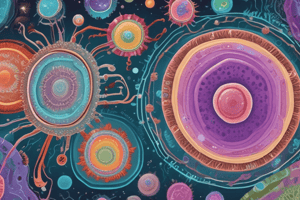Podcast
Questions and Answers
What is a characteristic of prokaryotic cells?
What is a characteristic of prokaryotic cells?
- Having multiple linear chromosomes
- Lacking membrane-bound organelles (correct)
- Having a true nucleus
- Having a complex cell structure
What is the main component of the cell wall in prokaryotic cells?
What is the main component of the cell wall in prokaryotic cells?
- Chitin
- Peptidoglycan (correct)
- Cellulose
- Lipopolysaccharides
How do prokaryotic cells typically reproduce?
How do prokaryotic cells typically reproduce?
- Meiosis
- Mitosis
- Fragmentation
- Binary fission (correct)
What is a feature of prokaryotic cells in terms of their growth rate?
What is a feature of prokaryotic cells in terms of their growth rate?
What is an example of a prokaryotic cell?
What is an example of a prokaryotic cell?
What is a role of prokaryotic cells in ecosystems?
What is a role of prokaryotic cells in ecosystems?
What is a feature of prokaryotic cells in terms of their metabolism?
What is a feature of prokaryotic cells in terms of their metabolism?
What is a way in which prokaryotic cells can be harmful to humans?
What is a way in which prokaryotic cells can be harmful to humans?
Flashcards are hidden until you start studying
Study Notes
Characteristics of Prokaryotic Cells
- Lack of membrane-bound organelles: Prokaryotic cells do not have a true nucleus or membrane-bound organelles.
- Single circular chromosome: Prokaryotic cells have a single circular chromosome found in the cytoplasm.
- Small size: Prokaryotic cells are typically smaller than eukaryotic cells, ranging from 0.5-5.0 μm in diameter.
- Simple cell structure: Prokaryotic cells have a simple cell structure with a cell wall and a plasma membrane.
Cell Wall
- Peptidoglycan (also known as murein): The cell wall of prokaryotic cells is composed of peptidoglycan, a thick layer of sugars and amino acids.
- Rigidity and support: The cell wall provides rigidity and support to the cell.
Reproduction
- Binary fission: Prokaryotic cells reproduce by binary fission, where the cell divides into two identical daughter cells.
- Fast growth rate: Prokaryotic cells can reproduce rapidly, with some species dividing every 20-30 minutes.
Metabolism
- Autotrophic and heterotrophic: Prokaryotic cells can be autotrophic (produce their own food) or heterotrophic (obtain food from other sources).
- Aerobic and anaerobic respiration: Prokaryotic cells can perform aerobic respiration (using oxygen) or anaerobic respiration (without oxygen).
Examples of Prokaryotic Cells
- Bacteria: Examples include E. coli, Staphylococcus aureus, and Bacillus subtilis.
- Archaea: Examples include methanogens, thermophiles, and halophiles.
Importance of Prokaryotic Cells
- Ecological roles: Prokaryotic cells play crucial roles in ecosystems, including decomposition, nitrogen fixation, and carbon cycling.
- Human health: Prokaryotic cells can be pathogenic, causing diseases such as tuberculosis and pneumonia, but they also play a role in the human gut microbiome.
Characteristics of Prokaryotic Cells
- Prokaryotic cells lack membrane-bound organelles, including a true nucleus.
- They have a single circular chromosome found in the cytoplasm.
- Their size ranges from 0.5-5.0 μm in diameter, making them typically smaller than eukaryotic cells.
- They have a simple cell structure with a cell wall and a plasma membrane.
Cell Wall
- The cell wall is composed of peptidoglycan, a thick layer of sugars and amino acids.
- The cell wall provides rigidity and support to the cell.
Reproduction
- Prokaryotic cells reproduce by binary fission, where the cell divides into two identical daughter cells.
- They can reproduce rapidly, with some species dividing every 20-30 minutes.
Metabolism
- Prokaryotic cells can be autotrophic, producing their own food through processes like photosynthesis.
- They can also be heterotrophic, obtaining food from other sources.
- They can perform aerobic respiration, using oxygen to generate energy.
- They can also perform anaerobic respiration, generating energy without oxygen.
Examples of Prokaryotic Cells
- Bacteria are a type of prokaryotic cell, including species like E. coli, Staphylococcus aureus, and Bacillus subtilis.
- Archaea are another type of prokaryotic cell, including species like methanogens, thermophiles, and halophiles.
Importance of Prokaryotic Cells
- Prokaryotic cells play crucial roles in ecosystems, including decomposition, nitrogen fixation, and carbon cycling.
- They can be pathogenic, causing diseases like tuberculosis and pneumonia.
- However, they also play a beneficial role in the human gut microbiome, aiding digestion and immune function.
Studying That Suits You
Use AI to generate personalized quizzes and flashcards to suit your learning preferences.




